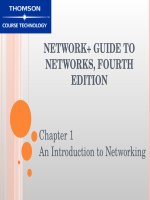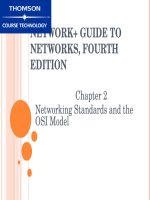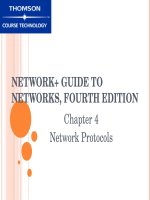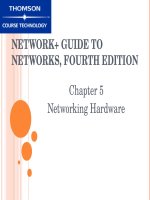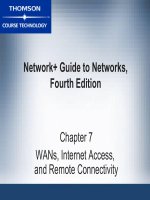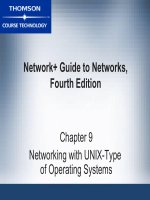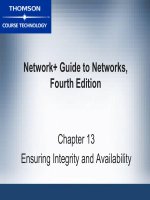Guide to network essentials 4th chapter 12
Bạn đang xem bản rút gọn của tài liệu. Xem và tải ngay bản đầy đủ của tài liệu tại đây (866.19 KB, 41 trang )
Chapter 12:
Wide Area and
Large-Scale Networks
Learning Objectives
Describe the basic concepts associated with
wide area networks (WANs)
Identify uses, benefits, and drawbacks of advanced WAN
technologies such as ATM, FDDI, SONET, and SMDS
Guide to Networking Essentials,
2
Wide Area Network (WAN) Transmission
Technologies
WAN spans large geographical area
Composed of individual LANs
linked with connection
devices like routers or switches
Use leased links from ISP or telco, including:
Packet-switching networks
Fiber-optic
cable
Microwave transmissions
Satellite links
Cable television coax systems
Guide to Networking Essentials,
3
Wide Area Network (WAN) Transmission
Technologies (continued)
Consider speed, reliability, cost, and availability when
choosing WAN technology
WAN can have different technologies tied together with
routers and gateways
Internet is largest WAN and combines all technologies
Three primary technologies are:
Analog
Digital
Packet switching
Guide to Networking Essentials,
4
Analog Connectivity
Public Switched Telephone Network (PSTN) or POTS (plain old
telephone system)
Uses
analog phone lines and modems, as shown
in Figure 12-1
Extremely slow, low quality but economic choice
Inconsistent quality because of circuit-switching
Table 12-1 lists PSTN line types and capabilities
Guide to Networking Essentials,
5
Simple PSTN Network Connection
Guide to Networking Essentials,
6
PSTN Line Types
Guide to Networking Essentials,
7
Analog Connectivity
Leased dedicated line improves quality
More
expensive but better data transmission
Line conditioning improves dedicated circuits
Results
in consistent transmission rate, improved
signal quality, and reduced interference and noise
Letters and numbers identify type of conditioning
Guide to Networking Essentials,
8
Analog Connectivity (continued)
To decide between dial-up or dedicated PSTN connection, consider
a number of factors:
Length
of connection time
Cost of service and usage levels
Availability of dedicated circuits, conditioning,
or other quality improvements
Assessment of need for 24-hour, seven-day
connection
Guide to Networking Essentials,
9
Digital Connectivity
Digital Data Lines (DDS) are direct or
point-to-point synchronous links
Transmit at 2.4, 4.8, 9.6, or 56
error-free transmission
Kbps with nearly 99%
Four kinds of DDS lines are ISDN, T1, T3, and switched 56K
Uses Channel Service Unit/Data Service Unit (CSU/DSU) instead
of modem
See Figure 12-2
Guide to Networking Essentials,
10
Simple DDS Network Connection Using
CSU/DSU Devices
Guide to Networking Essentials,
11
T1
Widely used high-speed digital line with maximum transmission rate
of 1.544 Mbps
Uses
two wires to transmit full-duplex data signals
One pair transmits; the other receives
24 individual channels, each with rate of 64 Kbps
Fractional T1 is subscription to one or more channels
Table 12-2 shows characteristics of European counterpart E1
Guide to Networking Essentials,
12
E Channels/Data Rates
Guide to Networking Essentials,
13
Multiplexing
Also called muxing
Several communication streams travel simultaneously over same
cable segment
Developed by Bell Lab for telephone lines
Used by T1 to deliver combined transmissions from several sources
over single line
Guide to Networking Essentials,
14
Channel Divisions
T1 has 24 separate channels, each supporting 64 Kbps data
transmissions
64
Kbps is known as DS-0 transmission rate
Full T1 using all 24 channels is called DS-1
Table 12-3 lists DS rate levels
Multiplexing can increase DS-1 rates up to
DS-4 speeds but requires fiber optic cables
Guide to Networking Essentials,
15
DS Channels/Data Rates
Guide to Networking Essentials,
16
T3
Contains 28 T1 lines or 672 channels
Transmits up to 44,736 Mbps
Fractional T3 lines may be leased in increments of 6 Mbps
Guide to Networking Essentials,
17
Switched 56K
Older digital point-to-point communication link
Pathway is established when customer needs
it and ends when transmissions end
Charged on per-minute usage
Guide to Networking Essentials,
18
Integrated Services Digital Network
(ISDN)
Single-channel links of 64 Kbps
Reasonable charges based on connect time
Speed is two to four times that of standard POTS modem
Two formats of ISDN
Basic Rate Interface (BRI) – Consists of two
B-channels (64 Kbps) for transmission and a
D-channel (16 Kbps) for call setup and control
Primary Rate Interface (PRI) – Consists of 23
B-channels and a D-channel
Guide to Networking Essentials,
19
Broadband ISDN (B-ISDN)
Emerging technology
Higher data rates than standard ISDN
Expected to operate from 64 Kbps to over 100 Mbps
Designed to work over fiber optic media
Guide to Networking Essentials,
20
Packet-Switching Networks
Provide fast, efficient, reliable technology
Internet is packet-switching network
Breaks data into small packets
Requires
retransmission only of packets with errors
May take different routes to destination where they
are reassembled
Figure 12-3 shows packet-switching network
Guide to Networking Essentials,
21
Simple Packet-Switching Network
Guide to Networking Essentials,
22
Virtual Circuits
Provide temporary “dedicated” pathways between two points
Logical
sequence of connections rather than
actual cable
Two types:
Switched
virtual circuits (SVCs) are established
only when needed and terminated afterwards
Permanent virtual circuits (PVCs) maintain
pathways all the time
Guide to Networking Essentials,
23
X.25
Interface between public packet-switching networks and their
customers
Connects
remote terminals with centralized
mainframes
SVC networks creating best pathway upon
transmission
Associated with public data networks (PDNs)
Use data terminal equipment (DTE) and
data communications equipment (DCE)
Guide to Networking Essentials,
24
X.25 (continued)
Three methods of connecting X.25 network:
X.25
NIC in computer
Packet assembler/disassembler (PAD)
LAN/WAN X.25 gateway
Reliable, error free communications
Decreasing in use because of speed limitations
Guide to Networking Essentials,
25
